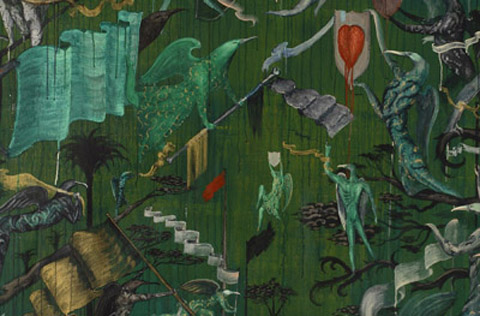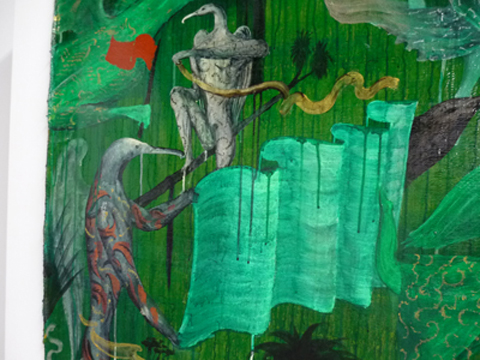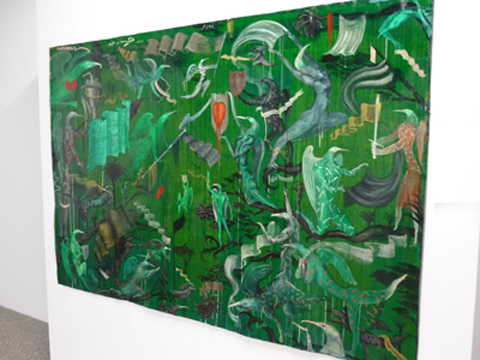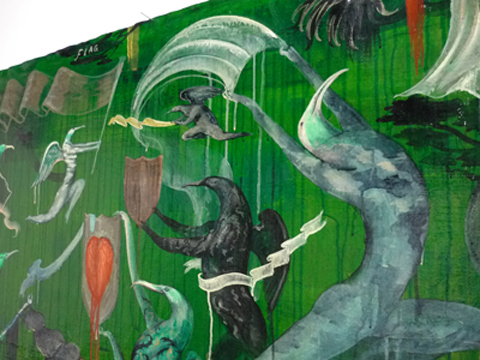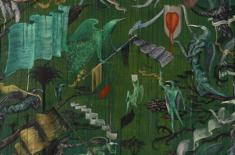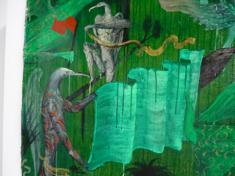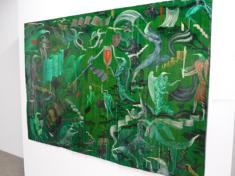Rob Garrett
Curator
Bill Hammond
Flag, 1997
The story of Bill Hammond’s inspirational trip to the Auckland Islands in 1991 is well known. How the islands showed him “a New Zealand before there were men, women, dogs and possums.” How the 19th century ornithological book “Buller’s Birds” – which is populated with illustrations of many bird species that have not survived to the present – provided part of his visual vocabulary. And since then, how Hammond has imagined himself in that New Zealand, before people arrived, through the surreal paintings he developed of birds-becoming-people. His dystopian birds have watched over forests and coastlines; waited for Buller’s return; witnessed the exfoliation of trees and the extinction of species; and communed among themselves. So, seeing flags – so festive! – fluttering against the sticky green of Hammond’s 1997 painting just confuses me.
I don’t know what these theatrically animated flag waving birds mean. I can’t explain them. All I can do is copy the semaphore gestures, which seem to spell “despair.” Plant a flag: claim a territory. Hoist a flag: celebrate a victory, announce a party. Flutter a pennant: declare your Mana, hurl a challenge. But raise a red flag? Warn of danger? Where: all around us? In the middle of the painting there is a green and black brocade-skinned bird holding aloft a shield with a bleeding heart; and below this, a winged messenger. What portent are they flagging? Are they flagging something, or simply flagging? What is it to flag? To flag hoists all sorts of down-beats into the swampy air: to give away; to give up; to tire; to give in. And there, in the upper right quadrant of the painting, next to the bleeding heart, is a large pale grey, striding bird-becoming-man, doing what? Is he throwing in the towel? Has it all become too much to bear anymore? I don’t know. This not knowing is the point I think.
In our land with so many flightless native birds, the picture of earth-bound birds with human bodies seems as ordinary and everyday as it is fantastical. I can imagine not being startled or surprised, if – when walking through the dripping, dark green wet bush of Fiordland – I found myself walking stride for stride next to one of Hammond’s birds. But if I did find myself walking next to one of these birds I might fear for my life, at least for my sanity. It would feel as if I had slipped through a slime hole – worm hole is wrong, being too extraterrestrial, whereas Hammond’s birds inhabit a swamp-world before memory. His bird demigods and their glossy dribbling green world want to suck us back beneath the present-day and into the primordial – water-logged earth, oozing tree sap and rank birds’ gullets – and prevent us taking flight. I would feel as if I had slipped into the realm of torment and dark mutilation conjured so well by Hammond’s contemporary – in this moment when time and space slip-slide with each other – Hieronymus Bosch.
“Flag” is a painting to drown in. Its power lies beneath its glossy surface of festive fluttering, suffocating sap-like green and ornate gold, rich red wounds and trees disported like wrought-iron Chinese filigree barring a window. Its power lies in the mysterious fact that this suppurating world looks so frightening – unavoidable and unknowable – and beautiful at the same time.
Bill Hammond, Flag, 1997, acrylic on un-stretched canvas, 1410 x 2130mm
Published in Important Paintings and Sculpture, 2 April 2009, Art+Object 21st Century Auction House, Auckland.
